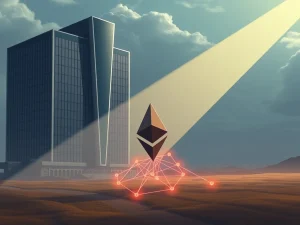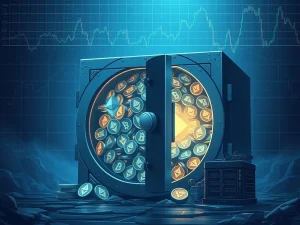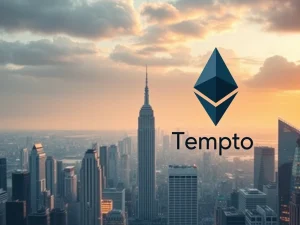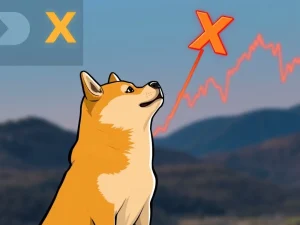Ethereum Price Prediction: Unlocking the Ethereum Rainbow Chart’s Astonishing $6,901 Target by August 2025
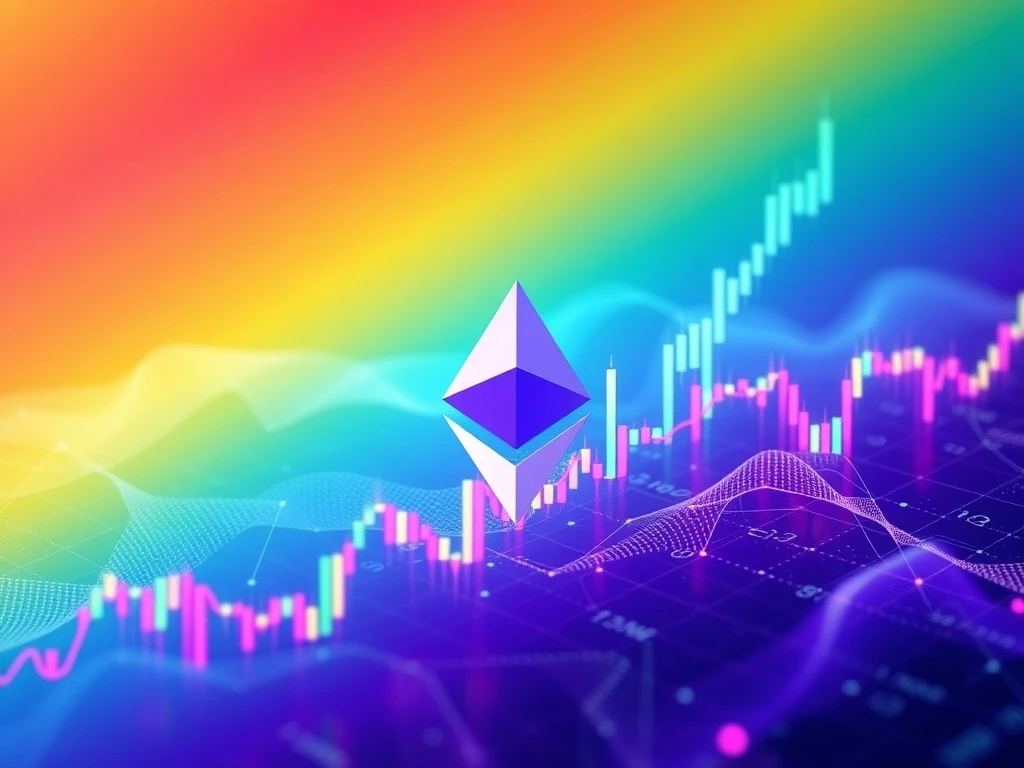
Are you keeping an eye on Ethereum’s future? The crypto world is buzzing with a new Ethereum price prediction that could redefine expectations. The renowned Ethereum Rainbow Chart model has recently turned heads with its forecast, suggesting a significant price range for ETH by August 1, 2025. This isn’t just a random guess; it’s a projection rooted in historical data and market sentiment, painting a vivid picture of where Ethereum might be headed.
Unveiling the Ethereum Rainbow Chart’s Prophecy: What Does it Mean for You?
The Ethereum Rainbow Chart, a fascinating logarithmic valuation tool, has become a go-to for many investors seeking to understand market phases. It visually categorizes price movements into color-coded bands, helping assess whether Ethereum is in an accumulation, euphoria, or distribution phase. This intuitive chart has now generated renewed attention with its bold forecast for August 1, 2025, predicting the cryptocurrency could trade between an impressive $4,752.48 and $6,901.15 on that date.
This projected range places Ethereum squarely in the “HODL!” zone of the model. For those new to crypto, “HODL” is a popular term derived from a misspelling of “hold,” signifying a strategy of holding onto cryptocurrency assets rather than selling them, especially during market volatility. When the Rainbow Chart signals “HODL!”, it indicates a period where long-term investors are encouraged to maintain their positions, expecting continued appreciation.
As of press time, Ethereum (ETH) was trading at $3,791. This current price situates it within the “Steady…” zone, which typically ranges from $3,298.74 to $4,752.48. This zone suggests stable growth and reduced volatility compared to more speculative or undervalued periods, offering a sense of calm before potentially entering the more bullish “HODL!” phase.
Understanding the different zones of the Rainbow Chart can provide valuable context:
- Fire Sale ($881.52–$1,193.99): Represents historical buying opportunities, often indicating extreme undervaluation.
- Undervalued ($1,193.99–$1,649.69): Still a strong buying opportunity, but less extreme than a fire sale.
- Steady… ($3,298.74–$4,752.48): Current zone, indicating stable growth and moderate volatility.
- HODL! ($4,752.48–$6,901.15): The predicted zone for August 2025, suggesting a strong period for holding assets.
- FOMO ($6,901.15–$9,510.38): Fear Of Missing Out – prices are rising quickly, attracting new investors.
- Sell ($9,510.38–$14,352.17): A zone where some investors might consider taking profits.
- Maximum Bubble Territory ($14,352.17–$20,456.93): Reflects peak exuberance and potential for a significant correction.
It’s important to remember that the model’s August 2025 target assumes continued bullish momentum without major macroeconomic or regulatory disruptions. While the Ethereum Rainbow Chart offers a structured framework, it’s one piece of a larger puzzle.
Decoding the Current ETH Price Forecast: What Do Technicals Say?
Beyond the colorful bands of the Rainbow Chart, traditional technical indicators provide crucial insights into the current ETH price forecast. These indicators often reinforce or challenge the sentiment-driven predictions, offering a more data-centric view of market momentum.
Currently, Ethereum’s trajectory is supported by strong technical signals. The 50-day simple moving average (SMA) stands at $2,836.31, while the 200-day SMA is at $2,404.22. Both of these key moving averages are significantly below the current trading price of $3,791. This divergence is a classic bullish signal, indicating sustained buying pressure and a healthy uptrend. When the short-term SMA is above the long-term SMA, and both are below the price, it typically suggests that the asset is in a strong upward momentum.
However, it’s not all clear skies. The 14-day Relative Strength Index (RSI) is currently at 80.01. The RSI is a momentum oscillator that measures the speed and change of price movements, ranging from 0 to 100. An RSI reading above 70 typically suggests that an asset is overbought, meaning its price has risen too quickly and might be due for a correction or consolidation. An RSI of 80.01 is a strong indication of overbought conditions, hinting at potential short-term consolidation or a pullback before continuing its ascent. This is a common pattern in strong bull markets, where assets can remain overbought for extended periods but still experience brief dips.
Investors should monitor these technical indicators closely. While the long-term outlook from the Rainbow Chart remains optimistic, the RSI suggests that short-term volatility or a healthy correction could be on the horizon. This doesn’t necessarily invalidate the long-term ETH price forecast but rather suggests a more nuanced approach to entry and exit points.
Beyond the Chart: Essential Ethereum News and Ecosystem Developments
The price of Ethereum isn’t just a function of charts and technical indicators; it’s deeply influenced by ongoing developments within its ecosystem and broader Ethereum news. Market analysts consistently contextualize price forecasts within Ethereum’s broader adoption trends and technological advancements.
One of the most significant factors bolstering Ethereum’s potential is its series of transformative upgrades. The proof-of-stake (PoS) transition, completed with ‘The Merge,’ dramatically reduced Ethereum’s energy consumption, making it more environmentally friendly and appealing to institutional investors focused on ESG (Environmental, Social, and Governance) criteria. This fundamental shift has improved the network’s security and efficiency, laying the groundwork for future scalability.
Following the PoS transition, the EIP-4844 (Cancun) upgrade, also known as ‘Proto-Danksharding,’ has been pivotal. This upgrade aims to significantly improve scalability by introducing ‘blobs’ for storing data, making transactions on Layer 2 solutions much cheaper and faster. Enhanced scalability is crucial for attracting more users and applications to the Ethereum network, which in turn drives increased network activity and demand for ETH. These developments could directly support the upper bound of the predicted range, as they make Ethereum a more robust and attractive platform for decentralized applications (dApps) and institutional capital.
Conversely, the path to the predicted range is not without potential hurdles. Prolonged bear markets, driven by global economic downturns or a general risk-off sentiment in financial markets, could cap prices closer to the lower end of the forecast. Similarly, unforeseen regulatory challenges from governments worldwide could introduce uncertainty and dampen investor enthusiasm. As the regulatory landscape for cryptocurrencies continues to evolve, any adverse rulings or restrictive policies could impact Ethereum’s growth trajectory.
Staying informed about these critical pieces of Ethereum news is essential for any investor. The success of network upgrades and the clarity of the regulatory environment will play a substantial role in determining whether Ethereum reaches its ambitious targets.
Navigating the Crypto Market Analysis Landscape: A Holistic View
While the Ethereum Rainbow Chart offers a compelling perspective, a comprehensive crypto market analysis demands considering a multitude of factors. Ethereum’s August 1, 2025, timeline also coincides with broader crypto market dynamics, where cross-asset correlations and macroeconomic forces often play a significant role.
Bitcoin’s price movements, for instance, often set the tone for the entire cryptocurrency market. While Ethereum’s performance is becoming less directly tied to Bitcoin’s halving events compared to its earlier days, investor sentiment and overall market liquidity can still be heavily influenced by what happens to the leading cryptocurrency. A strong Bitcoin bull run often creates a halo effect, lifting altcoins like Ethereum, while a significant Bitcoin correction can trigger broader market pullbacks.
Beyond crypto-specific events, global macroeconomic factors are increasingly impactful. Federal Reserve policy, including interest rate decisions and quantitative easing/tightening measures, directly affects the availability of capital and investor appetite for risk assets like cryptocurrencies. High inflation, geopolitical tensions, or a global recession could introduce external shocks that significantly alter projected trajectories, regardless of the strength of a particular crypto’s fundamentals.
It’s also crucial to acknowledge that the world of crypto price prediction is diverse. Competing models, including sophisticated machine learning algorithms and intricate on-chain analytics, often produce varied Ethereum forecasts. For example, some models might emphasize specific technical levels, such as $3,000 as a critical support level, highlighting the diversity of methodologies in crypto price prediction. This variance underscores the inherent uncertainties in predicting future asset prices in a nascent and rapidly evolving market.
For investors, this means that relying on a single model, no matter how compelling, is insufficient. A robust crypto market analysis strategy involves synthesizing insights from multiple data sources, understanding the underlying assumptions of each model, and staying abreast of global economic and regulatory developments. Market psychology and external factors remain significant variables, and a truly informed decision requires a holistic perspective.
The Ultimate Ethereum Price Prediction: What’s Next for ETH?
The Ethereum Rainbow Chart’s forecast for August 2025 places ETH firmly in the “HODL!” zone, reflecting cautious optimism about Ethereum’s long-term potential. This Ethereum price prediction suggests a period where maintaining your holdings could yield significant rewards, but it stops short of guaranteeing a specific outcome. The model provides a structured framework for evaluating market phases, offering a valuable lens through which to view Ethereum’s journey.
However, actual performance will depend on a confluence of real-world conditions. Continued institutional adoption is a major catalyst; as more traditional financial institutions and large corporations integrate Ethereum into their operations or invest in ETH, demand and price stability are likely to increase. The successful implementation of future network upgrades beyond EIP-4844, aimed at further enhancing scalability, security, and decentralization, will also be critical. These upgrades are vital for Ethereum to maintain its competitive edge and attract a wider user base.
Macroeconomic stability is another non-negotiable factor. A stable global economy, characterized by manageable inflation, predictable interest rates, and geopolitical calm, creates a more favorable environment for risk assets like cryptocurrencies to thrive. Conversely, periods of economic uncertainty or turmoil could dampen investor confidence and lead to capital outflows from speculative assets.
Therefore, while the Rainbow Chart is an insightful tool, it should be complemented by a broader analytical approach. Investors are urged to integrate on-chain metrics, which provide real-time data on network activity, transaction volumes, and user growth. Monitoring regulatory developments across different jurisdictions is equally important, as clear and favorable regulations can significantly de-risk the asset. Finally, keeping a close watch on macroeconomic trends will provide context for broader market sentiment and liquidity. By combining these diverse data points, you can form a comprehensive and nuanced outlook on Ethereum’s future, helping you navigate the exciting, yet volatile, world of crypto investing.
Frequently Asked Questions (FAQs)
1. What is the Ethereum Rainbow Chart?
The Ethereum Rainbow Chart is a logarithmic valuation tool that uses historical price data to categorize Ethereum’s price movements into color-coded bands. Each band represents a different market phase, such as “Fire Sale” (undervalued) or “Maximum Bubble Territory” (overvalued), helping investors gauge market sentiment and potential buying/selling opportunities.
2. What is the Ethereum Rainbow Chart predicting for August 2025?
The Ethereum Rainbow Chart predicts that by August 1, 2025, ETH could trade within a range of $4,752.48 to $6,901.15. This range places Ethereum in the “HODL!” zone, suggesting it will be a strong period for long-term holders.
3. What do the different color zones on the Rainbow Chart mean?
The zones represent various market sentiments and price levels: “Fire Sale” (deep undervaluation), “Undervalued,” “Steady…” (stable growth), “HODL!” (hold for long-term gains), “FOMO” (fear of missing out), “Sell” (potential profit-taking), and “Maximum Bubble Territory” (peak exuberance).
4. Are there other factors influencing Ethereum’s price besides the Rainbow Chart?
Yes, many factors influence Ethereum’s price, including network upgrades (like the proof-of-stake transition and EIP-4844), institutional adoption, broader crypto market dynamics (e.g., Bitcoin’s movements), global macroeconomic conditions, and regulatory developments. The Rainbow Chart is one tool among many.
5. Is the Ethereum Rainbow Chart a guaranteed prediction?
No, the Ethereum Rainbow Chart is a model based on historical data and sentiment, not a guarantee. While it provides a structured framework, actual performance depends on real-world conditions, unforeseen events, and market psychology. Investors should use it as a guide, not a definitive forecast.
6. What technical indicators support Ethereum’s current trend?
Technical indicators like the 50-day and 200-day Simple Moving Averages (SMAs) currently show bullish divergence, with both below the current price, indicating sustained upward pressure. However, the 14-day Relative Strength Index (RSI) at 80.01 suggests overbought conditions, hinting at potential short-term consolidation or a pullback.

